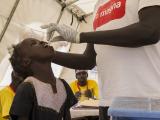Aug 16, 2002 (CIDRAP News) - Fresh produce is not generally considered a common source of foodborne illness but, in fact, the incidence of this problem is on the upswing, according to results of a survey published in the August issue of the Journal of Food Protection. In recent years, the number of cases of illness linked with eating fruits and vegetables has risen from 2% to about 8% of reported cases.
The increased incidence may be related to changing patterns of food consumption, recognition of new means for transmission of organisms, emergence of pathogens that can cause infections at very low doses, an expectation that most foods distributed in this country are safe, and/or a perception that foodborne illness does not occur at home.
Investigators at the Center for Consumer Research, Department of Food Science and Technology at the University of California, Davis, set out to look at consumer perceptions of safe food handling as related to disease transmission. They sent questionnaires to 2,000 randomly selected households asking about purchase, transport, storage, and preparation of fresh produce. Specific questions focused on handling of apples, broccoli, carrots, lettuce, melons, and strawberries, which represent a variety of textures and growth environments.
Respondents were also asked where they preferred to get information about safe handling of fresh fruits and vegetables. Demographic characteristics, including sex, ethnicity, education, income, and age, were also analyzed.
The response rate for the survey was 33%, with women representing 70% of the 624 respondents. Most of those responding (88%) were Caucasian, and 69% had some college education. Nearly one third of the group was age 65 or older, and median income was between $50,000 and $74,000. Recognizing the limitations of this study, the authors, Amy E. Li-Cohen and Christine M. Bruhn, make some thought-provoking observations.
Consistent with the findings of others, the authors point out that "higher-income households and people with at least a college degree are more likely to practice risky produce handling behavior compared with those with lower incomes and less formal education." They also note that convincing consumers to move to safer practices may not be easy, since one third of respondents were not interested in receiving free education materials on food safety.
Specific areas of concern include cross-contamination, handwashing, food storage, and cleaning procedures. Many consumers are unaware of the importance of storing meat, poultry, and seafood on the bottom shelf or in a meat and poultry drawer in the refrigerator. Similarly, the risk of cross-contamination from hands, knives, cutting surfaces, and sinks is often viewed as insignificant. Myths about cleaning techniques tend to persist to the point where products such as vinegar and baking soda are believed to be powerful antibacterial agents, according to the authors.
The researchers note that if education about food safety is to be effective, it must be simple, easy to follow, and, if possible, unobtrusive. They suggest that the best place to start may be the supermarket, where emphasis can be placed on separating meat, fish and poultry from foods that may be eaten without cooking. The grocery stores could also institute some simple point-of-sale information, such as illustrating how to use a plastic bag as a glove to protect both the hand and the food. Supermarkets also could provide brochures or cards explaining how to handle specific foods. An example is a card explaining that a specific melon should not be washed before it is refrigerated but should be very carefully washed before it is cut.
About one third of respondents in this survey said they preferred to learn about food safety through newspaper articles, information on supermarket bags, television programs, magazine articles, or refrigerator magnets. Different demographic groups also had varying preferences. Men, people from high-income households, college or postcollege graduates, and individuals 44 years old or younger seemed to prefer Web sites for information. Older people liked newspaper articles or instructions on containers, and many people, particularly those between the ages of 45 and 54, responded favorably to cooking shows that teach food safety.
In summarizing their findings, the authors point out that "People are more likely to follow a recommendation when they know why it is important. Since some are not interested in safe handling information and a comparison of previous with current research indicates that handling errors persist, research is needed on effective motivational strategies."
Li-Cohen AE, Bruhn CM. Safety of consumer handling of fresh produce from the time of purchase to the plate: a comprehensive consumer survey. J Food Protection 2002;65(8):1287-96
Food safety and the limits of education
Comment by Craig W. Hedberg, PhD, University of Minnesota
In this important survey of consumers' food-handling practices, Drs. Li-Cohen and Bruhn make the counterintuitive observation that "higher-income households and people with at least a college degree are more likely to practice risky produce-handling behavior compared with those with lower incomes and less formal education."
It seems that wealthy, well-educated people should be the most well informed about safe food-handling practices. What's with these people? Do they spend so much time reading the business pages that they ignore food safety information?
The authors suggest that educational outreach should target specific groups, including college graduates and higher-income households, because of their higher frequency of unsafe handling and washing practices. Is this really necessary? It may be that these groups actually have a reasonable knowledge of food safety and have made the reasoned judgement that the risk associated with their behavior is small compared with the benefit (perceived or real) they gain. In the case of fresh produce, cutting a few corners in preparing and serving food may save what for many is a precious, small commodity: time. Thus, the authors suggestion that effective food safety education must be simple, easy to follow, and unobtrusive is right on the money.
Evidence that wealthy, highly educated people are processing information on food safety and making their own judgements (not necessarily the ones public health officials would make for them) comes from FoodNet population surveys that have also looked at food consumption. The 1998-1999 Population Survey Atlas of Exposures (CDC, Atlanta, 1999) documents patterns of hamburger consumption. In general, persons at the highest income levels and college graduates were somewhat less likely to eat hamburgers (55% to 58%) than persons with less income or educational achievement (64% among high school graduates). Children under 10 had the highest rate of hamburger consumption (69%).
Among hamburger eaters, persons with the highest income levels and college graduates were most likely to eat pink hamburger (12% and 8%, respectively). However, less than 3% of children under 10 ate pink hamburger. Only 5% of hamburger eaters over 60 ate pink hamburger. These data suggest that the risks of eating pink hamburger are widely known and have had an impact on hamburger consumption for the persons at greatest risk for Escherichia coli O157:H7 infections: the very young and the elderly.
If the purpose of education is to give people the ability to analyze situations and make reasonable decisions, our food safety education programs may be doing a better job than the results of these surveys suggest. When the rate of contamination in a raw egg or a hamburger is on the order of 1 in 1,000 samples, an individual may make risky choices for many years without ill effect. On a population basis, however, that same level of contamination can translate into a large burden of disease. Thus, individual experience often conflicts with our population surveillance.
This has been the fundamental problem across public health education campaigns. What are the solutions? It seems unlikely that much benefit will come from directing education at groups that already have information. We can reinforce messages to protect those at highest risk, but that already seems to be happening. When we hit the wall of expected benefit from behavioral interventions, as suggested by the FoodNet data, the alternative is an engineering solution.
Fortunately, a major engineering solution to the problem of contaminated fresh meats and poultry already exists: irradiation. Safe, effective, and environmentally friendly technologies using electron beams and x-rays are making hamburgers safer and could greatly improve the safety of fresh produce by reducing the risk from cross-contamination on cutting boards and in kitchen sinks. Increasing the number and variety of irradiated foods that are available in the marketplace will lead to the next great reduction in foodborne illness.
And here's a bet: All those well-educated types who seem hard to reach with food safety education will be the biggest consumers of irradiated foods over the next 10 years.
Dr. Hedberg is associate professor, Division of Environmental and Occupational Health, School of Public Health, University of Minnesota, Minneapolis.


















